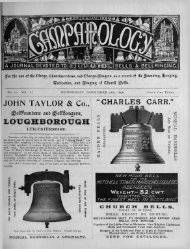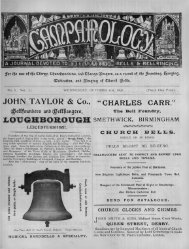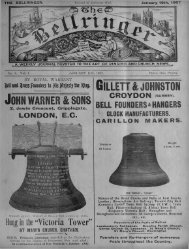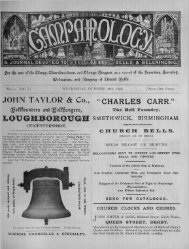The Central Council of Church Bell Ringers Education Committee
The Central Council of Church Bell Ringers Education Committee
The Central Council of Church Bell Ringers Education Committee
You also want an ePaper? Increase the reach of your titles
YUMPU automatically turns print PDFs into web optimized ePapers that Google loves.
else this would enable a learner to compare<br />
his/her efforts with their instructors and<br />
perhaps thereby improve their style. Has<br />
anyone produced such a device?<br />
<strong>The</strong> device was discussed in the following<br />
thread – ‘pullometer’ but some lower tech<br />
solutions were also discussed.<br />
Phil Gay - A fairly simple way <strong>of</strong><br />
demonstrating how little pull is required at<br />
backstroke is to get the learner to ring the bell<br />
by pulling only the backstroke. Initially the<br />
teacher will have to catch the sally to make<br />
sure the stay doesn't get broken, but with<br />
discouragement from pulling the learner will<br />
get to the stage where the bell rises almost to<br />
the balance at hand. <strong>The</strong>re is no corresponding<br />
exercise for the handstroke, but that needs<br />
to be pulled harder, so if you can get the<br />
backstroke right, the handstroke shouldn't be<br />
too much <strong>of</strong> a problem. Another thing I do is<br />
set the bell at back and then, with everyone<br />
standing well clear, pull the rope just enough<br />
to pull it <strong>of</strong>f. With many bells, the weight <strong>of</strong><br />
the rope is sufficient to set the bell at hand.<br />
No doubt some people will say the both <strong>of</strong> the<br />
above are dangerous and irresponsible, but if<br />
done carefully they are safe and provide very<br />
powerful demonstrations <strong>of</strong> an important<br />
point.<br />
Catherine Lewis pointed out - This bell is<br />
coming from the balance at back. On many<br />
occasions the bell doesn't get there in the first<br />
place and so more effort is actually needed to<br />
get it up at hand.<br />
It was suggested that there was little advice<br />
on correcting the problem <strong>of</strong> over pulling and<br />
the problem was not well understood.<br />
John Harrison disagreed – he felt - the<br />
problem is communicating that understanding<br />
to people who have the problem.<br />
He uses three approaches to cure over<br />
pulling-<br />
1 - At the foundation stage, we do a lot <strong>of</strong><br />
lifting to the balance. We also do a lot <strong>of</strong><br />
7<br />
practice setting at backstroke. Most <strong>of</strong> our<br />
bells are light set, and with long ropes, there is<br />
no way you can set them without a fairly<br />
gentle touch.<br />
2 - I use the rope tension exercise (<strong>The</strong> Tower<br />
Handbook p 167).<br />
3 - Having given the learner the experience <strong>of</strong><br />
what rope movement with a light tension feels<br />
like, I then coach them while ringing to<br />
reduce tension, ie stand with them and tell<br />
them to reduce the force gradually, while still<br />
controlling the bell. It is pretty easy to see<br />
whether they are doing so, and certainly when<br />
they revert. Being told that they have just<br />
increased force and to reduce it, not only<br />
helps keep them on the straight and narrow,<br />
but helps them learn what the symptoms <strong>of</strong><br />
escalating force feel like.<br />
Pullometer<br />
Although it was agreed that this was an old<br />
topic it received a good airing<br />
John Harrison said that he had looked into<br />
the idea in the 1990s and had suggested a<br />
fairly high-tech solution which he tried to get<br />
developed by university engineering<br />
departments. Later it was suggested that<br />
standing on bathroom scales might give some<br />
data. I did some experiments, and confirmed<br />
that there were indeed quite large observable<br />
differences between the excursions <strong>of</strong> the dial<br />
with different people ringing the same bell in<br />
rounds. From memory, I could keep the swing<br />
under about 2-3 stones, while less experienced<br />
ringers had it swinging up to 10 stones.<br />
He felt the development <strong>of</strong> a device which<br />
could record information would be very<br />
useful.<br />
Nick Smith - <strong>The</strong> ability to record the<br />
readings is very important. In addition to<br />
pulling too hard many learners also pull for a<br />
very short distance. As a consequence if you<br />
succeed in getting them to reduce the level <strong>of</strong><br />
heave the bell then drops because the short<br />
pull results in too little energy being input to<br />
the bell. A recording would show up the<br />
learner’s pull as a spike whereas the









